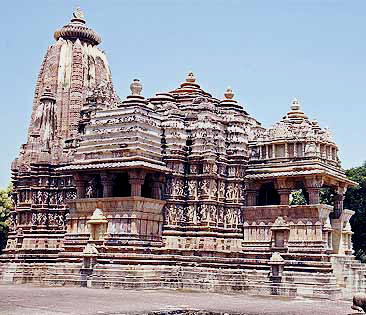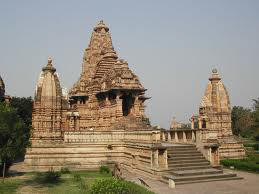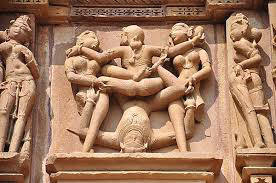|
Khajuraho is famous for its
magnificent temples dedicated to Lord Shiva, Lord Vishnu and the
Jain Tirthankaras. These temples are built between 950 A.D. and
1050 A.D. The temples of Khajuraho represent some of the most
exquisite specimens in medieval India, only 22 temples out of 85
now survive.
History
The art of Khajuraho India h as
a long history. Today the art of Khajuraho India is world
renowned. The beautiful temples that dot the town of Khajuraho are
believed to have been built by the mighty Chandela rulers in 9th
and 10th century AD. The engravings on these temples are highly
sensual and erotic and much has already been discussed their
symbolic importance. Tantricism and the Shakti cult, where the
pancha makaras (five tenets), namely, matsya (fish), madira
(wine), maithun (sexual activity), mamsa (meat), and mudra
(gesture) were to release the human spirit from the bondage of the
flesh, have been described as the possible explanations for the
sculptural sensuality of Khajuraho. as
a long history. Today the art of Khajuraho India is world
renowned. The beautiful temples that dot the town of Khajuraho are
believed to have been built by the mighty Chandela rulers in 9th
and 10th century AD. The engravings on these temples are highly
sensual and erotic and much has already been discussed their
symbolic importance. Tantricism and the Shakti cult, where the
pancha makaras (five tenets), namely, matsya (fish), madira
(wine), maithun (sexual activity), mamsa (meat), and mudra
(gesture) were to release the human spirit from the bondage of the
flesh, have been described as the possible explanations for the
sculptural sensuality of Khajuraho.
Out of 85 temples, only 20 have survived the ravages of time. Made
of sandstone blocks fitted together, the temples are aligned
east-west. For convenience, these may be divided into western,
eastern, and southern groups of temples.
Places of Interest
The temples of Khajuraho are divided into three geographical
groups viz, Western, Eastern, and Southern groups.Devi Jagdamba
Temple
Western Group of Temples
Chausath Yogini One of the three granite temples in Khajuraho.
Dedicated to Kali, it is also unique in being quadrangular. Only
35 of the original 65 cells remain and the image is the earliest
surviving shrine
Kandariya Mahadeo It is the largest and most typical Khajuraho
temple. Perfectly symmetrical, it soars 31m high.
Devi Jagdamba Temple Another Kali temple, originally dedicated
to Vishnu.
Chitragupta Temple North of Devi Jagdamba temple and facing
eastwards to the rising sun, dedicated to Surya, the Sun God. The
idol, an imposing 5 feet in height, is driving a seven-horsed
chariot.
Vishwanath Temple The steps Vishwanath Temple leading to the
temple on the northern side are flanked by lions and on the
southern side by elephants. There is a impressive three-headed
image of Brahma inside.
Eastern Group of Temples
Brahma Temple, Vamana Temple and Javari Temple
A double row of celestial nymphs adorn the outer wallsof the
 Vamana
temple in a variety of sensuous attitudes. Granite was used in the
construction of the Brahma temple. Vamana
temple in a variety of sensuous attitudes. Granite was used in the
construction of the Brahma temple.
Parsvanath Temple The largest Jain temple in this group.
Sculptures on the northern outer wall make this timeless, of a
woman bending thoughtfully over a letter, a damsel removing a
thorn from her foot.
Ghantai Temple
Bearing evidence of its original splendour, particularly arresting
is a frieze depicting the dreams of Mahavir's mother and a multi
armed Jain goddess riding on the winged Garuda.
Southern Group of Temples
Dulhadeo Temple
Archaeological Museum
Chaturbhuj Temple
Excursions
Dhubela Museum : 64 km. Located on the bank of the lake, the
museum houses a wide variety of Shakti Cult Sculpture. There are
different sections on garments, weapons and paintings.Timings :
1000 -1700 hrs.
How to get there
Air: Indian Airlines services connect Khajuraho with Delhi
Rail : Jhansi (175 Km.) and Satna (117 Km.) are the two
convinient railheads to visit Khajuraho from Bombay, Delhi &
Madras. However Harpalpur (110 Km,) is the nearest railhead to
visit Khajuraho.
Road : Khajuraho is connected with major tourist centres by
good motorable roads. Some important distances from Khajuraho are:
Agra (395 km), Allahabad (285 km), Bandhavgarh (237 km), Bhopal
(372 km) Chitrakoot (176 km), Delhi (590 km), Jabalpur (296 km)
Lucknow (267 km) and Varanasi (415 km)
Bus service : Direct bus services connect Khajuraho with Panna,
Satna, Rewa, Jabalpur, Jhansi, Harpalpur, Mahoba, Bhopal, Indore
and Agra. |